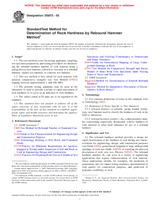Wir benötigen Ihre Einwilligung zur Verwendung der einzelnen Daten, damit Sie unter anderem Informationen zu Ihren Interessen einsehen können. Klicken Sie auf "OK", um Ihre Zustimmung zu erteilen.
ASTM D5873-05
Standard Test Method for Determination of Rock Hardness by Rebound Hammer Method
Automatische name übersetzung:
Standard Test Methode zur Bestimmung der Gesteinshärte von Rückprallhammer -Methode
NORM herausgegeben am 1.11.2005
Informationen über die Norm:
Bezeichnung normen: ASTM D5873-05
Anmerkung: UNGÜLTIG
Ausgabedatum normen: 1.11.2005
SKU: NS-32905
Zahl der Seiten: 3
Gewicht ca.: 9 g (0.02 Pfund)
Land: Amerikanische technische Norm
Kategorie: Technische Normen ASTM
Die Annotation des Normtextes ASTM D5873-05 :
Keywords:
core, hardness, rock mass, rock, unconfined compressive strength, ICS Number Code 13.080.20 (Physical properties of soil)
Ergänzende Informationen
| Significance and Use | ||||||||||||||||
|
The rebound hardness method provides a means for rapid classification of the hardness of rock during site characterization for engineering, design, and construction purposes (see Guide D 420), geotechnical mapping of large underground openings in rock (see Guide D 4879), or reporting the physical description of rock core (see Practice D 4543). The rebound hardness number, H r, can serve in a variety of engineering applications that require characterization of rock material. These applications include, for examples, the prediction of penetration rates for tunnel boring machines, determination of rock quality for construction purposes, and prediction of hydraulic erodibility of rock. This test method is of limited use on very soft rock or very hard rock (unconfined compressive strengths less than approximately 1 MPa or greater than 100 MPa). The results of this test method are not intended for conversion to strength data suitable for design. Note 1—Several types of rebound hammers are commercially available to accommodate testing of various sizes and types of concrete construction (See Test Method C 805) and rock material. Note 2—The quality of the result produced by this standard is dependent on the competence of the personnel performing it, and the suitability of the equipment and facilities used. Agencies that meet the criteria of Practice D 3740 are generally considered capable of competent and objective testing and sampling. Users of this standard are cautioned that compliance with Practice D 3740 does not in itself assure reliable results. Reliable results depend on many factors; Practice D 3740 provides a means of evaluating some of those factors. |
||||||||||||||||
| 1. Scope | ||||||||||||||||
|
1.1 This test method covers the testing apparatus, sampling, test specimen preparation, and testing procedures for determining the rebound hardness number of rock material using a spring-driven steel hammer, referred to variously as a rebound hammer, impact test hammer, or concrete test hammer. 1.2 This test method is best suited for rock material with uniaxial compressive strengths (see Test Method D 7012) ranging between approximately 1 and 100 MPa. 1.3 The portable testing apparatus may be used in the laboratory or field to provide a means of rapid assessment of rock hardness or to serve as an indicator of rock hardness. 1.4 The values stated in SI units are to be regarded as the standard. 1.5 This standard does not purport to address all of the safety concerns, if any, associated with its use. It is the responsibility of the user of this standard to establish appropriate safety and health practices and determine the applicability of regulatory limitations prior to use. |
||||||||||||||||
| 2. Referenced Documents | ||||||||||||||||
|
Empfehlungen:
Aktualisierung der technischen Normen
Wollen Sie sich sicher sein, dass Sie nur die gültigen technischen Normen verwenden?
Wir bieten Ihnen eine Lösung, die Ihnen eine Monatsübersicht über die Aktualität der von Ihnen angewandten Normen sicher stellt.
Brauchen Sie mehr Informationen? Sehen Sie sich diese Seite an.




 Cookies
Cookies
